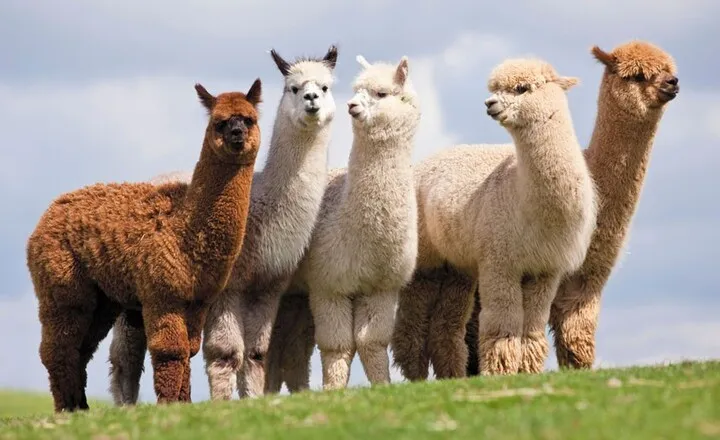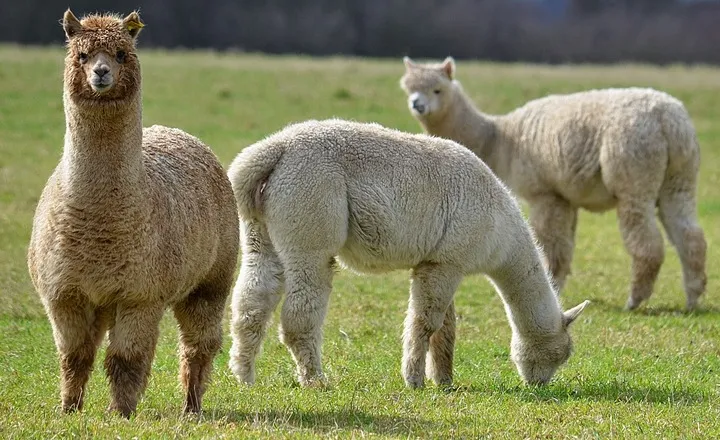From the majestic Suri llama with its long, flowing locks reminiscent of a fairytale character to the sturdy and hardworking Woolly llama bred for its luxurious fiber, each type brings something special to the table.
Whether you’re a llama enthusiast or simply curious about these enchanting creatures, join us on a journey in which we have discussed 5 Types of Llamas with Origin, Characteristics, and Facts.
5 Types of Llamas with Origin
They come in various types, each with its own unique characteristics and qualities. The Classic Llamas, also known as Ccara Sullo, are the most common type and are known for their versatility and strength.
Medium Llamas are another type that falls in between the smaller alpacas and larger llamas in terms of size. Suri Llamas have a distinct fleece quality with long, silky locks that set them apart from other types.
Vicuna Llamas are a rare and prized type known for their fine fleece, which is considered one of the most luxurious fibers in the world.
Wooly Llamas have a dense and fluffy coat that gives them a unique appearance compared to other types. Each type of llama has its own charm and appeal, making them all equally adorable in their own way.
1. Classic Llamas (Ccara Sullo)
Classic Llamas, also known as Ccara Sullo, are a unique variety of llamas distinguished by their long double-coated fleece and fine undercoat. Their striking appearance and larger size set them apart from other llama varieties, making them a popular choice among breeders and enthusiasts.
The term classic in their name pays homage to their beautiful coat, which is characterized by an abundance of guard hair covering their entire body.
Habitat
Llamas are indeed hardy and adaptable animals that can thrive in a variety of environments, including urban farm settings. While they are commonly associated with mountain terrains, their ability to endure different weather conditions makes them well-suited for various climates.
Traditional llamas, with their thick wool coats, are particularly resilient in cold northern winters as the wool provides insulation to keep them warm.
Classic Llamas can also acclimate well to hot and humid temperatures if provided with proper care.
Characteristics
Classic llamas are known for their distinctive physical characteristics that set them apart from other llama varieties. Their large bodies and double-coated fleece with long hair create a saddle-like appearance, making them easily recognizable.
The key feature to distinguish Classic llamas, specifically the Ccara Sullo variety, is by examining their ears. Unlike other llama types with spear-shaped ears, Classic llamas have rounded tips on their ears, serving as a clear giveaway of their breed.
They also have sharp hooves that differentiate them from other types of llamas. This trait can be another identifying factor when trying to determine the specific breed of a llama.
The combination of these physical characteristics makes Classic llamas stand out in terms of appearance and helps enthusiasts and breeders identify them accurately within the llama community.
2. Medium Llamas
Medium llamas are a lesser-known variety of llama that possess a unique charm and cool demeanor. With medium wool and smaller body structures compared to other llama types, they stand out for their distinct appearance.
Despite not being as widely recognized, medium llamas are certainly worth getting to know for their individual characteristics and beauty.

If you’re just learning about medium llamas now, it’s never too late to appreciate these fascinating creatures. Their cool looks and calm nature make them a delightful addition to the world of llamas.
Habitat
Medium llamas are known for their adaptability to different habitats, including mountain terrains and other environments. While they are typically found in colder temperatures, llamas can also thrive in hot and humid weather with proper care.
The wool of llamas helps them stay warm in cold climates, so it is important not to shear them if they are living in colder regions.
Shearing the llamas can help them stay cool and comfortable in hotter climates. With the right attention to their needs, medium llamas can survive and even thrive in various habitats beyond their natural mountain terrain.
Characteristics
Medium llamas are a unique blend of wooly and traditional llamas, exhibiting characteristics from both types.
They often have a fluffy coat like wooly llamas but maintain the stature and appearance of classic llamas. The breeding process involves crossing different llama varieties to produce these distinctive medium llamas with a mix of traits.
While distinguishing between medium and wooly llamas can be challenging, there are subtle differences that set them apart.
Medium llamas typically have a more balanced combination of wooliness and traditional llama features, whereas wooly llamas tend to have a heavier and denser coat.
3. Suri Llamas
They are indeed a rare and unique variety of llamas that are at risk for extinction. The name Suri comes from the special type of fiber that these llamas produce, which must hang a certain way to be classified as Suri.
Despite their historical popularity and successful show ring history, Suri llamas are now facing the threat of extinction if conservation efforts are not taken seriously.
It is important to raise awareness about the plight of Suri llamas and advocate for initiatives to preserve this rare breed. With their diverse bloodlines and unique characteristics, Suri llamas have a rich history that deserves to be protected for future generations to appreciate.
By supporting conservation efforts and promoting responsible breeding practices, we can work towards ensuring the survival of these fascinating creatures.
Habitat
The Suri Llama, once native to mountain terrains, is now sparsely populated across different continents such as North America, South America, and parts of Europe.
Despite efforts by breeders to save the breed, their numbers remain shockingly low, with less than a hundred individuals in Europe.

The main challenges faced in increasing their population is the difficulty in breeding them due to a limited genetic pool available to experienced breeders.
Breeders have been relocating Suri Llamas to various farms in urban, rural, and countryside areas in an attempt to preserve the species.
The lack of significant population growth suggests that more concerted efforts may be needed to address the breeding challenges and expand the genetic diversity of this unique species.
Wool
Wool Suri, specifically referring to the well-defined locks from the skin to the end of the lock, is a unique and distinctive characteristic found in certain llama breeds. These locks often resemble twisted or corkscrew pencil shapes, adding to their visual appeal.
The fleece of Suri llamas is particularly prized for its extreme slickness, shine, and curly texture, making it a sought-after material for various textile applications.
Due to their continuous growth, Suri llamas require regular shearing every one to two years to maintain the quality and health of their fleece.
This process helps in preserving the integrity of the locks and ensures that they continue to grow in a uniform and desirable manner. The distinct features of Wool Suri make it a valuable resource in the world of fiber production and craftsmanship.
4. Vicuna Llama
The Vicuna Llama is indeed a fascinating creature known for producing a luxurious and rare type of wool that surpasses even cashmere in softness.
Indigenous to the Andes Mountains of South America, vicuna wool is highly prized for its quality and is used to create expensive sweaters and overcoats.
What makes this wool so valuable is the fact that it takes the fiber of 30 llamas to produce just one coat, highlighting the exclusivity and scarcity of this material.
As they refuse to be domesticated or kept in captivity. Once they are shorn for their wool, they must be released back into their natural habitat, emphasizing their independence and need for freedom.
With their beautiful orange coats and white patches, these majestic creatures symbolize both luxury and untamed beauty, making them a unique and cherished species in the Andes region.
Characteristics
Vicuna is a stunning animal with its tawny brown coat and elegant body structure. Its most distinctive feature is its beautifully colored wooly coat that is adorned with long, luxurious hair.
A striking contrast can be seen in the white color of the hair on the neck and throat region, adding to the overall beauty of this graceful creature.
It also possesses a gentle and timid nature, making it a fascinating animal to observe in its natural habitat. These characteristics, combined with its unique coat and coloring, contribute to the allure and charm of the Vicuna as one of nature’s most captivating creatures.
Wool
Vicuna wool is one of the most luxurious and sought-after fibers in the world. Known for its exceptional softness and warmth, vicuna wool is highly prized by luxury fashion designers and discerning consumers.
The rarity of vicuna wool adds to its allure, as these animals can only be shorn every three years, producing a limited amount of fiber each time.
With an average annual yield of only 0.5 kg per vicuna, the scarcity of this precious wool further contributes to its high price tag.
The intricate process involved in collecting and processing vicuna wool also adds to its exclusivity, making it a symbol of wealth and sophistication.
5. Wooly Llamas
They may be smaller in size compared to other llama breeds, but they are certainly not lacking in charm. Known for their adorable appearance and fine quality wool, these llamas are highly sought after by breeders for their unique traits.
With the limited online presence of information about wooly llamas, those familiar with the breed understand and appreciate its value.
The different types of wool produced by wooly llamas, ranging from light to heavy, offer a variety of options for those interested in working with this breed.
While they may not be as widely recognized as other llama types, wooly llamas continue to hold a special place among enthusiasts and breeders who recognize their distinct qualities and potential for breeding purposes.
Habitat
They are typically found in mountainous regions where they have evolved to thrive in cold weather conditions.
Their thick woolly coats provide insulation and protection from the elements, making them well-suited for high altitudes and chilly temperatures. Despite their natural preference for colder climates, llamas can also be successfully raised on farms with proper care and attention.
They are also capable of surviving in hot weather conditions with some precautions. Providing shade, access to fresh water, and monitoring their exposure to extreme heat are essential for ensuring the well-being of llamas in warmer environments.
Wool
Wooly llamas are a unique breed known for their single-layered strong wool covering. Unlike Classic Llamas, they do not have an undercoat, resulting in a thick and kinky fiber texture.
The wool on Wooly llamas is especially dense on the head, ear, and neck areas, similar to ordinary alpaca fiber but with fewer guard hairs. This makes them ideal for producing high-quality wool products with a soft and luxurious feel.

The fiber quality of Wooly llamas is often compared to that of alpacas, but with its own distinct characteristics. The lack of an undercoat and the minimal presence of guard hair contribute to a smoother and more consistent wool texture.
This makes Wooly llamas a sought-after breed for those looking to work with premium wool fibers that have a unique blend of softness and durability.
Interesting Facts About Llamas
Llamas are fascinating creatures with a range of unique characteristics. They are known for their intelligence, docile nature, and ability to be trained easily.
Thet interesting fact about llamas is that they communicate with their owners through humming, which adds to their charm and appeal as pets or working animals.
Another intriguing aspect of llamas is their method of expressing agitation – they spit on their owners and fellow herd members when feeling angry or annoyed.
Their poop is odorless and serves as an excellent eco-friendly fertilizer, showcasing the practical benefits of these animals beyond just companionship. They are not only intelligent protectors but also have practical uses in agriculture and farming practices around the world.
Conclusion
Llamas are fascinating creatures with a wide range of characteristics that make them unique among camelids. From the regal appearance of the suri llama to the friendly nature of the classic llama, each type has its own distinct qualities.
Whether you are looking for a working companion or simply a delightful pet, there is a llama breed suited to your needs. By learning more about these 5 types of llamas, you can better appreciate and understand these remarkable animals.
FAQs
Is an alpaca a type of llama?
They may appear similar at first glance, but they are actually two distinct species within the camelid family. Alpacas are smaller in size compared to llamas, with a more delicate appearance and finer fiber.
What are wild llamas called
Wild llamas are known as guanacos in South America, where they roam the rugged landscapes with grace and determination.
What is a female llama called?
A female llama is called a dam. Dams are responsible for giving birth to and nursing the young llamas, known as crias.
